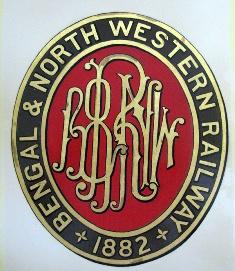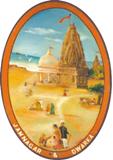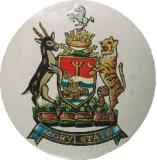
Nizam's Guaranteed State Railway (NGSR) was a railway company operating in India from 1879 to 1950. It was owned by the Nizams of Hyderabad State, and its full name was His Exalted Highness, The Nizam's Guaranteed State Railway. The company began with a line built privately by the HEH, the Nizam, which was owned and operated by the company under a guarantee from the Hyderabad State, much to the dismay of the British authorities. Capital for the line was raised by issuing redeemable mortgage debentures. The Nizam's railway was eventually consolidated with the Hyderabad-Godavari Valley Railway (HGVR). In 1951, both the NGSR and the HGVR were nationalised and merged into Indian Railways.
The Jessore–Jhenidah Light Railway was a 29-mile-long (47 km) 2 ft 6 in narrow gauge railway in British India, now in Bangladesh. It was constructed in 1913, and was dismantled in 1969. It operated 0-4-4T, 0-6-2T, 2-4-0T, and 0-8-0T locomotives of mostly German manufacture. The railway developed a reputation for being poorly managed, an official report in 1915 states that staff could not nominate one person as their manager.

Cutch State Railway (CSR) was an isolated 2 ft 6 in (762 mm) narrow gauge railway in Cutch State, one of the princely states allied to Britain in India.

Bengal Provincial Railway was a 2 ft 6 in narrow-gauge railway from Tarakeswar to Magra, in Indian state of West Bengal.

Bhavnagar State Railway (BSR) was a metre gauge railway line in Bhavnagar State, now part of Gujarat in India.

Gaekwar's Baroda State Railway (GBSR) or Gaikwad Baroda State Railway was a narrow gauge railway line owned by the Princely State of Baroda, which was ruled by the Gaekwar dynasty.

Diwan Bahadur Thaticonda Namberumal Chetty was an Indian contractor, engineer, builder and businessman who constructed a number of public buildings in the city of Madras in the late 19th and early 20th centuries.

The South Indian Railway Company operated a number of 1,000 mm gauge lines in South India from 1874 to 1951.

The Eastern Bengal Railway was one of the pioneering railway companies that operated from 1857 to 1942, in the Bengal and Assam provinces of British India.

The Assam Bengal Railway (ABR) was one of the pioneering railway companies in British India. Headquartered in Chittagong, it functioned from 1892 to 1942.
The Bengal Dooars Railway was formed in 1891 and amalgamated with the Eastern Bengal Railway in 1941. The Bengal Dooars Railway was one of the pioneering railway companies that operated from 1893 to 1941, in Bengal province of British India, connecting the Dooars with its junction with Eastern Bengal Railway at Lalmonirhat with locations up to the foot of the Himalayas near the border with Bhutan.

The Bengal and North Western Railway was owned and worked by the Bengal and North Western Railway Company. The Bengal and North Western Railway was merged into the Oudh and Tirhut Railway on 1 January 1943.

Rohilkund and Kumaon Railway (R&KR) was a metre gauge railway in India covering a total network of 592 miles (953 km). It was owned and worked by the Rohilkund and Kumaon Railway Company. The Rohilkund and Kumaon Railway was transferred to the Government of India and merged into the Oudh and Tirhut Railway on 1 January 1943.

Jamnagar & Dwaraka Railway was a 1,000 mm metre gauge in the Nawanagar State in Gujarat during 19th century.

Morvi Railway (MR) was a 1,000 mm (3 ft 3+3⁄8 in) metre gauge line in the princely state of Morvi in Gujarat, India.

Dehri Rohtas Light Railway (DRLR) was a 2 ft 6 in narrow gauge railway line between Dehri-On-Sone and Tiura Pipara Dih in the state of Bihar, India.

Mysore State Railway (MSR) was a railway company which was operated by the government of the Kingdom of Mysore. After India's constitution into a republic, MSR became part of Southern Railways of the government of India on 14 April 1951.

The Gondal State Railway (GSR) was a metre gauge railway owned by the Gondal State.

The Junagadh State Railway (JunSR) was a metre gauge railway owned by the Junagadh State and initially worked by the Bhavnagar–Gondal–Junagadh–Porbandar Railway. From 1911 the JunSR worked itself as an independent system, owned by the Junagadh Durbar, until 1948 when it became part of the Saurashtra Railway.

Dibru–Sadiya Railway (DSR) was one of the pioneering railway companies in British India and the first railway service of Assam in north-east India.






















